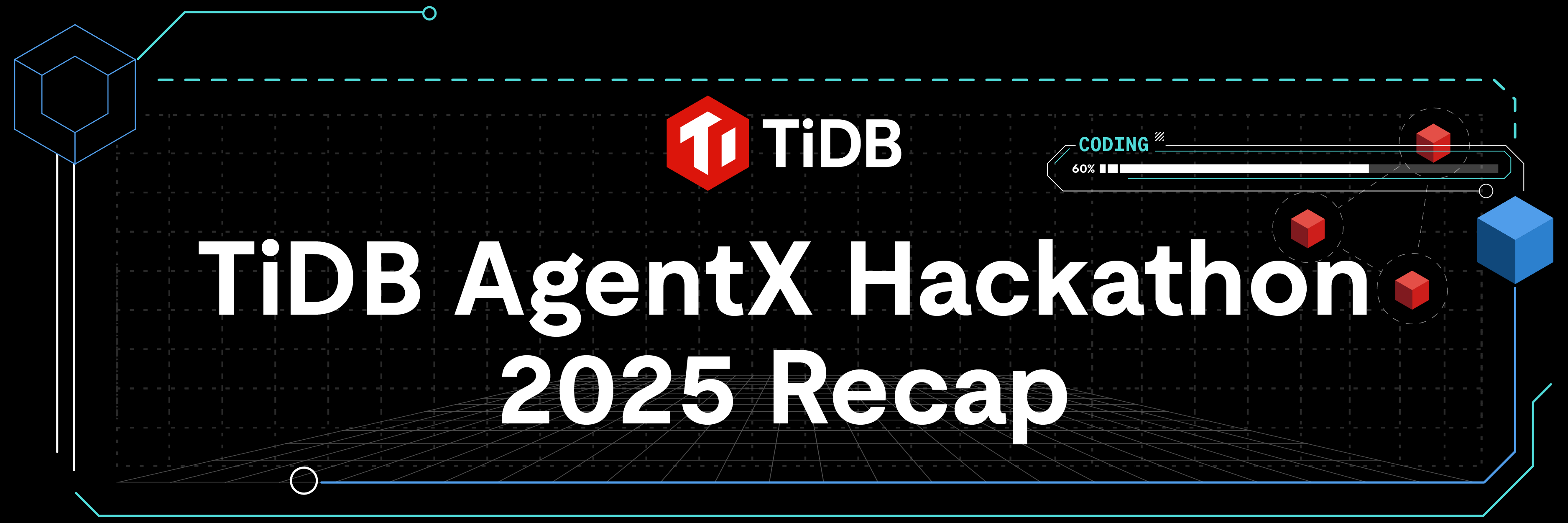
The results are in, and they are spectacular. When we challenged the community to move beyond simple RAG demos, we never imagined the sheer ingenuity we’d see. With 219 incredible submissions, the AgentX Hackathon 2025 proved one thing: the era of sophisticated, multi-step AI agents is here.
A New Chapter for TiDB Hackathons
Last year’s hackathon introduced developers to vector search on TiDB Cloud Serverless (now called TiDB Cloud Starter). This year, we challenged participants to build systems that think, decide, and act across multiple steps. The theme “Forge Agentic AI for Real-World Impact” pushed developers to orchestrate complex workflows combining vector search, full-text search, Model Context Protocol, LLM reasoning, and external integrations.
The shift from single-step retrieval to multi-agent coordination represents a fundamental evolution in how developers approach AI applications.
Celebrating Our Winners
We had a ton of amazing projects, but these five really stood out. The judges picked them because they didn’t just build something cool, they actually solved real problems. Let me show you what made them special.
🥇 First Place: PetFit AI

Born from a personal crisis when a young cat broke his leg with no vet available, PetFit AI transforms pet healthcare through multi-agent orchestration. The system ingests real-time collar data via Kafka, stores it in TiDB with TTL configuration, and deploys specialized agents for symptom analysis, audio interpretation, skin disease detection, and vitals monitoring. The central orchestrator coordinates these agents to provide comprehensive pet health insights, demonstrating exactly what we envisioned for agentic AI.
🥈 Second Place: EduPath

A law student turned CS applicant who spent thousands on consultants built the solution he wished existed. EduPath uses TiDB vector search across 100 universities to match students with target, reach, and safe schools through natural conversation. The AI extracts profile data seamlessly, generates personalized timelines, and democratizes expensive graduate school guidance. This solution proves agentic AI can make professional services accessible to everyone.
🥉 Third Place: AutoIR

AutoIR turns noisy AWS logs into explainable incident reports. The system embeds CloudWatch logs, performs semantic search in TiDB, and uses an LLM orchestrator with safety guardrails (SELECT-only queries, enforced LIMITs) to generate incident summaries with evidence. With sub-2-second end-to-end performance and production-grade deduplication logic, AutoIR showcases how careful architecture makes agentic systems reliable.
Additional Winners
🏅 4th Place – Heydesk: A solo developer built both a customer support platform and the first .NET SDK for TiDB Vector Search, TiDB Vector & .NET, demonstrating remarkable technical ambition.
🏅 5th Place – AI Member of Parliament: Event-driven agentic system for civic engagement, automating case handling workflows inspired by Singapore’s Meet-the-People Sessions.
🌟 Best Social Good – FamCare: Healthcare management for aging families, combining vector search for medical documents with external APIs (OpenFDA, RxTerms) for comprehensive care coordination.
🏆 Best Open Source – ElitOrcAI: Clinical decision support chaining medical image analysis, vector similarity search, and structured diagnostic guidance for healthcare professionals.
Three Key Trends That Defined the Winners
Three key patterns emerged across the 219 submissions:
- Hybrid Search is Standard: Winners combined vector search with full-text search rather than relying on semantic matching alone. This approach delivered superior relevance for everything from pet symptom matching to knowledge base retrieval.
- Multi-Agent Orchestration: The sophistication leap from last year is striking. Projects didn’t just call an LLM, they coordinated specialized agents, implemented safety guardrails, and built genuine multi-step reasoning systems.
- Production Mindset: Winning teams thought about operational concerns from day one. We saw TTL configuration for data lifecycle management, deduplication logic for alert storms, multi-tenant isolation, and sub-2-second performance optimization.
Why TiDB’s Architecture Matters
Winners leveraged TiDB in ways that would require multiple databases otherwise. PetFit needed TTL, vector search, full-text search, and Chat2Query in one system. AutoIR combined vector embeddings with SQL analytics. Heydesk built multi-tenant vector search with collection filtering. TiDB’s mixed workload processing capabilities, handling both transactions and analytics on the same data, proved essential for real-time agentic workflows.
What’s Next
We’re reaching out to participants for deeper conversations about their technical choices and challenges. These insights will shape TiDB’s roadmap and documentation. We’ll also highlight winning projects through blog posts, podcasts, and technical deep dives.
The TiDB AgentX Hackathon demonstrated that agentic AI has moved from research curiosity to practical reality. Developers are ready to build systems that reason across multiple steps and solve real problems with autonomous workflows. We’re excited to see what the community builds next.
Thank you to everyone who participated, your innovation inspires us. Want to build your own agentic AI system? Get started with TiDB Cloud Starter for free and see what you can create. We can’t wait to see what you build next.
Spin up a database with 25GiB free resources.
TiDB Cloud Dedicated
A fully-managed cloud DBaaS for predictable workloads
TiDB Cloud Starter
A fully-managed cloud DBaaS for auto-scaling workloads



